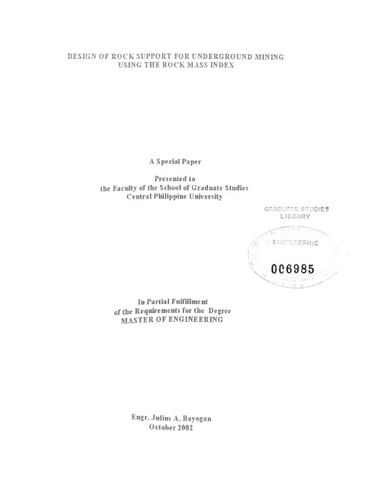Design of rock support for underground mining using the rock mass index
| dc.contributor.adviser | Rio, Walden S. | |
| dc.contributor.author | Bayogan, Julius A. | |
| dc.date.accessioned | 2021-02-18T08:18:49Z | |
| dc.date.available | 2021-02-18T08:18:49Z | |
| dc.date.issued | 2002 | |
| dc.identifier.citation | Bayogan, J. A. (2002). Design of rock support for underground mining using the rock mass index (Unpublished Master’s special paper). Central Philippine University, Jaro, Iloilo City. | en_US |
| dc.identifier.uri | https://hdl.handle.net/20.500.12852/471 | |
| dc.description | Abstract only | en_US |
| dc.description.abstract | This special paper presents the basic procedures in the design of underground rock support using the newly developed rock mass classification, the Rock Mass Index (RMi) method. The Rock Mass index is based on the defined inherent parameters of rock masses combined with the compressive strength of intact rock and a jointing parameter. The jointing parameter represents the main jointing features, namely the block volume, joint roughness, joint alteration and joint size. The RMi system involves a more systematic collection and application of the geological input data. RMi also makes use of a clearer definition of the different types of ground. It probably covers a wider range of ground conditions and includes more variables. The application of RMi in the design of rock support has treated the rock mass separately into continuous, discontinuous and weakness zone in the assessment of the stability and rock support. The input parameters and procedures for the assessment of the stability and the rock support on these three types of rock masses are practically different since their behaviors are markedly different. The stability of an underground opening in a continuous material is related to the intrinsic strength and deformation of the bulk material while stability in a discontinuous material depends primarily on the character of the joints and the block size. The stability assessment of the underground opening is therefore, to divide the rock mass into continuous and discontinuous ground, which is determined by the continuity factor (CF). Discontinuous ground occurs when CF is equal to 5-100, else the ground is continuous. The methods of rock support design in continuous, discontinuous ground and weakness zone is reflected in different equations and calculations. The mathematical expressions have been given for all applications and parameters, which is worked out in a computer spreadsheet program in the calculations. Using the computer spreadsheets (Excel) to calculate the value of RMi and the support parameters can quickly make the computations because the relevant equations and input parameters are linked in the spreadsheet The computerization of the calculations will facilitate the decisions making on the rock support to be implemented on a certain area. The spreadsheet program was based on the procedures and mathematical expressions presented in the RMi method. It gives the input parameters for the support charts to determine the range of rock support of continuous, discontinuous and weak zone ground. The spreadsheet is a user friendly, and accessible even without the knowledge of computer programming. The user would only input available parameters gathered from geological investigations, through subsurface exploration during the early design stage. Modifications of the estimates will be made when the values or ratings of the input factors have been measured or observed. The final output of the design will indicate the type of support requirements necessary to stabilize the rock structure. It includes the spacing, length of rockbolts with its corresponding combination of shotcrete thickness or a specially design concrete lining given by the support charts. The support chart for continuous rock mass is separate from the combined support chart of discontinuous and weakness zone because of the difference in input parameters. Tables, support charts for the three main groups of rock masses: continuous, discontinuous and weakness zones and the computer spreadsheets are presented together with several examples computed manually and using the computer spreadsheet. Some descriptions and pointers are given in the spreadsheets for proper and easy use. | en_US |
| dc.format.extent | i, 85 leaves. | en_US |
| dc.language.iso | en | en_US |
| dc.subject.ddc | GSL Theses 620.0072 B345 | en_US |
| dc.subject.lcsh | Mining engineering | en_US |
| dc.subject.lcsh | Tunneling | en_US |
| dc.subject.lcsh | Rocks--Classification | en_US |
| dc.subject.lcsh | Excavation | en_US |
| dc.subject.lcsh | Rock excavation | en_US |
| dc.title | Design of rock support for underground mining using the rock mass index | en_US |
| dc.type | Special paper | en_US |
| dc.contributor.chair | David, Fely P. | |
| dc.contributor.department | School of Graduate Studies | en_US |
| dc.description.degree | Master of Engineering | en_US |


